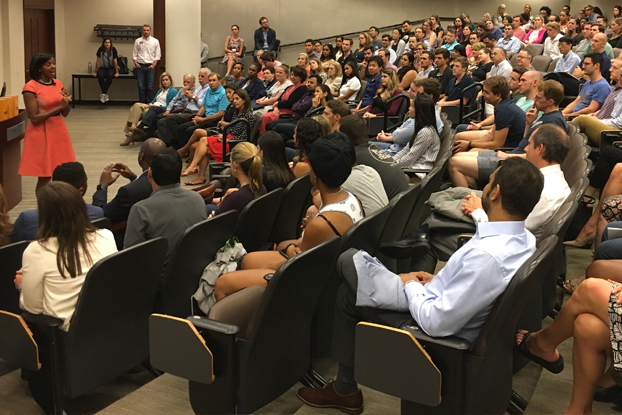Cultures are living, evolving entities, and corporate cultures are no exception. But who defines a given company’s work habits, policies, values, and priorities? Those occuping the C-suite or those in the cubicles? It’s not an either-or answer, according to several panelists at the 6th Annual Diversity Leadership Conference, held at Emory University’s Goizueta Business School and sponsored by the school’s Black MBA Association. Corporate culture is negotiated space where employees and leaders meet halfway to create a professional atmosphere that satisfies company goals and employee expectations, with the end result playing a significant role in the company’s performance and successes.
—–
Should you adapt to a corporation’s culture or should it adapt to you? Or is this a shared responsibility? That was one of several questions discussed at the 6th Annual Diverse Leadership Conference, held on April 1, 2011, and sponsored by Emory University’s Goizueta Business School and Black MBA Association.
During a session on “Global Diversity in a Digital World: Leveraging Human Capital,” facilitators Julius Pryor, senior vice president at Your Talent Bridge, a diversity talent management firm, and Michael Johnson, vice president of HR at UPS, asked the audience about corporate culture. Can you change a corporate culture or must you assimilate to it? Johnson offered his own company as an example.
“At UPS, you used to have to wear a suit and tie; you had to put on your coat to have a cup of coffee and put the cup on a tray, no coffee on your desk,” he said. “Now, we have business casual and dress-down days. Who influenced that change? The employees.”
But this doesn’t mean employees should expect a company to adapt to their habits or preferences without some negotiation. “I want to be clear: Yes, companies should meet you halfway to help you assimilate and you should meet them halfway to assimilate. But a culture, while it can be influenced to change, cannot be changed by one individual,” stressed Johnson.
People define diversity by the differences among people rather than the similarities, said Pryor. “But you can’t create a corporate strategy unless you’re thinking about both.”
So what kinds of things do many companies look for in employees these days? Workers who are bilingual, transnational (have lived in other countries), data-driven, comfortable in fast-changing environments, and who can move in and out of teams. “Now, a leader has to be able to get in front of a team at one point and then fall back into the middle the next,” said Pryor.
These strategies explained the eventual success of UPS in Germany. In the beginning, the mentality was, “We’re going to teach the Germans how to be UPS people,” said Johnson. After making no money between 1975 and 1990, the company decided, “maybe we should hire some Germans so they can help us be successful!” After the German operation began to flourish, UPS changed overseas strategies. Their current strategy is geared toward joint partnerships with local companies already in the delivery business, and after understanding the way of doing business in a specific location, UPS converts the company and staff into a UPS operation.
“We try to reduce our numbers of expats — U.S. folks going over there to impose their will on people,” said Johnson. “The shift we made accelerated our success — and that in itself was a diversity exercise,” said Johnson.
This theme of corporate culture and diversity was echoed in the panel called “Break through the Glass Ceiling: Strategies for Successful Women in the Corporate Realm & Entrepreneurship.”
“If you notice that you and your corporate culture are at odds, I would strongly suggest looking for an organization that really matches up to the things that are important to you,” said panelist Sara Buchanan, founder and CEO of Your Talent Bridge. By way of example, she described her years of working at BellSouth, which had a conservative, unionized culture, and her realization that she needed to work in a more entrepreneurial atmosphere. She advised job-hunters to seek out employees of prospective companies to get a feel for the corporate culture before signing on.
Willingness to learn more about another culture can be multifaceted. “A lot of my colleagues are white, middle-aged men,” noted Chi Chi Okezie, owner and producer of SIMPLEnetworking, a company that teaches people how to network. “For them, recreation is not going to the movies or sitting home watching Girlfriends. So in order to interact with them and understand how my industry is moving, I had to learn to play golf. I wasn’t compromising my beliefs; you just have to learn the skills you need to move to the next level.”
When asked about strategies for breaking the glass ceiling, Rhonda Mims, president of ING Foundation and senior vice president of corporate responsibility and multicultural affairs at ING, a financial services firm, said she made sure she reached out to people who would help her, based on previous successes. “If I worked with someone to acquire a university as a client, I would get that person to be my advocate because they knew what my skill set was. And they became my sponsor,” she noted. “A sponsor is not someone you go up to and ask, ‘Hey will you be my sponsor?’ but rather someone who knows what you can bring to the table and will speak up for you in those talent management meetings to get you that promotion.”
But make sure your work is exemplary before you ask people to be your mentor or sponsor, added Buchanan. When you’re a top performer, “what often happens is you start to be tapped, to be asked, ‘How did you accomplish that?’ From that I ended up meeting with people individually over lunch and asking them, ‘What have you done to be successful?’ It was a strategic move on my part.”
You need to have a career plan, she added. “Start with your end goal and ask yourself, ‘What are things I need to do—in bite-sized chunks, year by year or month by month—to achieve that? If your goal is to become part of the leadership ranks, seek out female leaders in your organization and ask them, ‘What did it take to be successful? What do I need to do to increase my game?’”
Just be sure that this mentorship is a two-way street, so that you are offering something in addition to asking for help. Mims mentioned that one of her mentors is a much younger woman who gives her advice on social media.
Of course, all this advice is meaningless if not put into action. Pryor concluded his presentation with this African proverb: “Every morning, a gazelle wakes up. It knows it must run faster than the fastest lion or it will be killed. Every morning a lion wakes up. It knows it must outrun the slowest gazelle or it will starve to death. The moral? It doesn’t matter whether you are a lion or a gazelle; when the sun comes up, you’d better be running!”
RELATED CONTENT:
HBR: A Good Way to Change Corporate Culture
The Multicultural Advantage: Corporate Culture Shock in America
Wall Street Journal: On Diversity, America Isn’t Putting Its Money Where Its Mouth Is
Wall Street Journal Women in the Economy: Recommendations for Moving Forward










